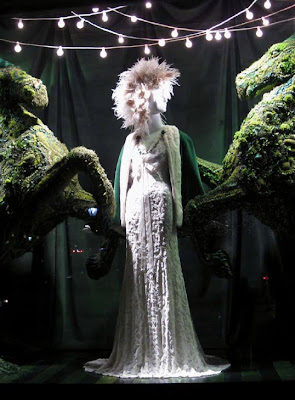
Our third annual edition of Holiday Bytes is finally here! Please click the image above to view the PDF. All of us at MBF Trend Consulting wish you happy holidays and a joyous new year. This is our last post of 2009. See you in the new year!

In support of the United Nations Climate Change Conference in Copenhagen, there have been over 3,000 events going on worldwide in hopes of establishing effective solutions of the world crisis. Organized by community leaders and individuals desiring to seek change, people all over the world are organizing candlelight vigils, wall signings, and marches in their cities and local towns. Bornholm, a small Danish island of population 43,000, also recently developed a program to cut its emissions to zero by developing clean energy. They are burning straw for district heat, using wind power for electricity, and developing a biofuels plant and infrastructure for electric cars. Rome is also now the first European capital to launch a plan for energy self-sufficiency, using more wind turbines and solar panels.
In addition, Native Land, Stop Eject also opened in Kunsthal Chalottenborg, Copenhagen last Saturday December 5, and continues till February 21, 2010. From the perspective of nomads, islanders, and indigenous people, the exhibition gives them a voice to speak on how the climate crisis is affecting human migration in all parts of the world.
And to give you the latest update on the Climate Change Conference in Copenhagen, the EU leaders have committed to 3.6 billion dollars a year until 2012 to help developing countries. And the two countries, Norway and Mexico, have proposed a joint model for climate funding, using both the incomes from the UN-allowances and from individual countries.
The call to urgency and immediate action is louder than ever. And as there are only a few remaining days left of the Climate Change Conference in Copenhagen, we hope that the agreements are finalized and change is near. As the 3.6 million supporters of Avaaz says to the three key leaders, Obama, Hatoyama, and Merkel, “fund the fight to save the world.”
After a year of email correspondences, negotiations, and business trips to North Korea, they managed to seal a deal with the country’s biggest mining company to produce 1,100 pairs of two styles of jeans, expected to go on sale this Friday, December 4th.
Priced at 150 Euros each and stitched with a "Made in North Korea" label, the team has designed limited straight-cut, dark-washed jeans, stark in its design to resemble the North Korean landscapes. With the launch includes a documentary of the company's trip to North Korea, exposing the world of it's rather transparent production method and further insight of an enigmatic nation.
As it is North Korea’s first denim product, it is likely that Noko’s first collection of jeans, Maneuvers in the Dark, will sell out in no time. However, although Noko has the cool, edgy look for a premium denim brand, it is still questionable as to whether their “Made in North Korea” tags will be embraced by their denim loving consumers. But even then, as North Korea may not have the best connotations, it’s isolated and somewhat secretive identity may work to Noko’s advantage, providing an unmarked territory as grounds to help spark a more positive association.
Noko’s website does not yet include the details of where you can purchase these jeans, but check back shortly and we’ll let you know as soon as we find out!
Via: Refinery29
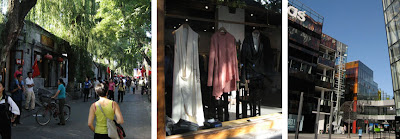 Going to Beijing, all the guidebooks urge visitors to shop at the markets, where stall after stall of vendors hawk camera batteries, fake designer bags, and gaudy cell phone accessories. To see the best of Chinese design, and find a few souvenirs actually worth carrying home, it's best to avoid those tourist traps.
Going to Beijing, all the guidebooks urge visitors to shop at the markets, where stall after stall of vendors hawk camera batteries, fake designer bags, and gaudy cell phone accessories. To see the best of Chinese design, and find a few souvenirs actually worth carrying home, it's best to avoid those tourist traps. There's really no comparison between Chinese food in the United States or Europe and Chinese food in China. One is typically cheap, greasy, uninventive, and sometimes bland; the other is a smorgasbord of different cuisines, from Uighur to Sichuan to Cantonese, with an astonishing range of flavors and textures. In Beijing, the ever-present street vendors hawk all sorts of stuffed pancakes, roasted vegetables and nuts, and sweet or savory pastries, all for under a dollar; while restaurants range from tiny local dives to ultra-fine dining, with minimalist décor and maximalist prices, attentive waitstaff and jewel-like confections served in course after course. Beer is the usual drink with dinner, often Tsingtao or Nanjing.
There's really no comparison between Chinese food in the United States or Europe and Chinese food in China. One is typically cheap, greasy, uninventive, and sometimes bland; the other is a smorgasbord of different cuisines, from Uighur to Sichuan to Cantonese, with an astonishing range of flavors and textures. In Beijing, the ever-present street vendors hawk all sorts of stuffed pancakes, roasted vegetables and nuts, and sweet or savory pastries, all for under a dollar; while restaurants range from tiny local dives to ultra-fine dining, with minimalist décor and maximalist prices, attentive waitstaff and jewel-like confections served in course after course. Beer is the usual drink with dinner, often Tsingtao or Nanjing.



 As a lower-powered alternative to conventional lightbulbs, LEDs have lately emerged from the stuff of blinking signs into many aspects of our daily lives. Times Square and Las Vegas are already famous for their flashing, colorful LED billboards, but lately we’ve been noticing a few NYC buses and subway entrances festooned with LED advertisements. As fashion channels developments in the world around us, it is no surprise that designers have been adapting this technology into their collections.
As a lower-powered alternative to conventional lightbulbs, LEDs have lately emerged from the stuff of blinking signs into many aspects of our daily lives. Times Square and Las Vegas are already famous for their flashing, colorful LED billboards, but lately we’ve been noticing a few NYC buses and subway entrances festooned with LED advertisements. As fashion channels developments in the world around us, it is no surprise that designers have been adapting this technology into their collections. Well, we snagged a password to the much-hyped Rent the Runway and after a good rummage around the site, we're simply underwhelmed. As it stands, the site carries 124 dresses and two jumpsuits by 27 (mostly contemporary) designers, and some of those dresses don't even appear to be in stock yet. Prices are about 10% of retail.
Well, we snagged a password to the much-hyped Rent the Runway and after a good rummage around the site, we're simply underwhelmed. As it stands, the site carries 124 dresses and two jumpsuits by 27 (mostly contemporary) designers, and some of those dresses don't even appear to be in stock yet. Prices are about 10% of retail.  For your average fashion fan, without benefit of Anna Wintour's six-figure clothing allowance, the closest she'll come to owning a runway dress is buying a Forever 21 knockoff. Two recent MBAs in New York had another idea, though: why not rent designer dresses to women at a fraction of their retail price?
For your average fashion fan, without benefit of Anna Wintour's six-figure clothing allowance, the closest she'll come to owning a runway dress is buying a Forever 21 knockoff. Two recent MBAs in New York had another idea, though: why not rent designer dresses to women at a fraction of their retail price? Well, from the sound of it, things are looking up: The recession's over, say the experts! Sales are up at Saks and Nordstrom, and expected to be even better for Christmas!
Well, from the sound of it, things are looking up: The recession's over, say the experts! Sales are up at Saks and Nordstrom, and expected to be even better for Christmas! "it telegraphed Stella McCartney’s optimistic spring message as obviously as Trey Speegle’s huge paint-by-numbers mural of the Arc de Triomphe emblazoned with a giant YES."


 First, Anna Wintour was spotted walking to work. Then Grace Coddington outed herself as a subway rider. Now, as the latest result of 25% across-the-board cuts at Condé Nast, Self mag editrix Lucy Danziger is getting profiled by the NY Times — for her newfound routine of commuting by bike.
First, Anna Wintour was spotted walking to work. Then Grace Coddington outed herself as a subway rider. Now, as the latest result of 25% across-the-board cuts at Condé Nast, Self mag editrix Lucy Danziger is getting profiled by the NY Times — for her newfound routine of commuting by bike.  Yesterday's "Save the Garment Center" rally was well-attended — by fashion students, garment workers, and even high-end designers, reports the NYT — but it looks like the district could already be making a comeback. In a far cry from this summer — when Mayor Bloomberg proposed to consolidate the entire NYC garment industry into a single building — the city is now sponsoring incubator studios for young designers, who will be selected in a competition.
Yesterday's "Save the Garment Center" rally was well-attended — by fashion students, garment workers, and even high-end designers, reports the NYT — but it looks like the district could already be making a comeback. In a far cry from this summer — when Mayor Bloomberg proposed to consolidate the entire NYC garment industry into a single building — the city is now sponsoring incubator studios for young designers, who will be selected in a competition.  The annual CFDA/Vogue Fashion Fund spread is out in this month's Vogue, and surprise! Not one, but two sustainable designers are among the 10 nominees: womenswear designer Alabama Chanin and jewelry designer Monique Péan.
The annual CFDA/Vogue Fashion Fund spread is out in this month's Vogue, and surprise! Not one, but two sustainable designers are among the 10 nominees: womenswear designer Alabama Chanin and jewelry designer Monique Péan. 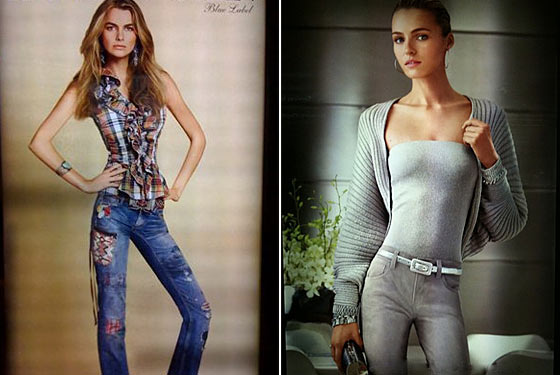
 So everyone and their mother has been presenting their lines via film lately, as we've been covering... but promoting a film by creating fashion lines — that's a new one for us!
So everyone and their mother has been presenting their lines via film lately, as we've been covering... but promoting a film by creating fashion lines — that's a new one for us!  While the big names at the Bryant Park tents and MAC at Milk were busily hogging most of the attention at NYFW, a small, green revolution was going on in Soho... on Greene Street, naturally! With EarthPledge's usual high-profile FutureFashion show on hiatus, a new player stepped into the mix: TheGreenShows, featuring our longtime fave Bodkin along with pieces from Ekovaruhuset (above), a boutique carrying intricately crafted work from international designers; along with collections from Bahar Shahpar, Lara Miller, Izzy Lane, Mr. Larkin, and Study by Tara St. James, with makeup by eco-beauty line Suki.
While the big names at the Bryant Park tents and MAC at Milk were busily hogging most of the attention at NYFW, a small, green revolution was going on in Soho... on Greene Street, naturally! With EarthPledge's usual high-profile FutureFashion show on hiatus, a new player stepped into the mix: TheGreenShows, featuring our longtime fave Bodkin along with pieces from Ekovaruhuset (above), a boutique carrying intricately crafted work from international designers; along with collections from Bahar Shahpar, Lara Miller, Izzy Lane, Mr. Larkin, and Study by Tara St. James, with makeup by eco-beauty line Suki. As Fashion Week evolves from industry event to public phenomenon, designers have been contemplating how to keep their shows exclusive while making all of their customers feel included. Fashion's Night Out, while not a financial success, was a big step toward the democratization of Fashion Week, letting the public meet (or at least gape at) influential designers and buy in by, well, buying in.
As Fashion Week evolves from industry event to public phenomenon, designers have been contemplating how to keep their shows exclusive while making all of their customers feel included. Fashion's Night Out, while not a financial success, was a big step toward the democratization of Fashion Week, letting the public meet (or at least gape at) influential designers and buy in by, well, buying in.  New York has gone bike crazy this summer, and David Byrne would like at least some of the credit, please. Best known as the geek-chic Talking Heads frontman, Byrne has been doing some thinking lately about how urban life could be better. And it revolves around bicycles — you see, he's been riding one around New York for 30 years.
New York has gone bike crazy this summer, and David Byrne would like at least some of the credit, please. Best known as the geek-chic Talking Heads frontman, Byrne has been doing some thinking lately about how urban life could be better. And it revolves around bicycles — you see, he's been riding one around New York for 30 years.  Both are 1) open late, 2) extremely well-connected, 3) rife with celebrity appearances, and 4) swarming with enthusiastic visitors, making it 5) nearly impossible to filter out the noise… but at the same time, 6) neither has turned out to be the instant moneymaker everyone thought they would be.
Both are 1) open late, 2) extremely well-connected, 3) rife with celebrity appearances, and 4) swarming with enthusiastic visitors, making it 5) nearly impossible to filter out the noise… but at the same time, 6) neither has turned out to be the instant moneymaker everyone thought they would be.The problem isn't that people don't like shopping, it's that they have no [unprintable term] money!


A survey released in May by the Retail Industry Leaders Association, which measured the first four months of 2009, found 61 percent of retailers had seen an increase in amateur and opportunistic shoplifting, while 72 percent had seen an increase in organized retail crime.
In a move straight out of a cops-and-robbers movie, one gang has been stealing jewelry from J.C. Penney's locations in Texas and Louisiana by hoisting themselves down from the roof.
But it's not all customers who are doing the thieving. In Chicago, high-end clothing boutique Jake has stiffed 28 designers for sums ranging from $860 to $48,000 by closing down their parent company and opening a new one, while continuing to run the shop itself under the same name.
The designers have collectively filed suit to recover their unpaid money; for smaller designers such as Costello Tagliapietra, the more than $20,000 they are owed represents a significant chunk of their business, while 3.1 Phillip Lim's brand director, Maria Vu, says the suit is also a matter of principle.
Regardless of the outcome, the designers, whose numbers also include Chris Benz, Lutz & Patmos, and Band of Outsiders, are pleased to have banded together created a community where they can discuss the issues facing them collectively as young designers..

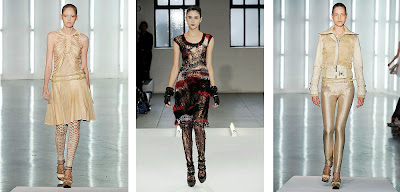 Many high-end designers seem to be on the same invisible wavelength, spontaneously creating nearly identical versions of a mutton-sleeve blazer or drape-front pants for the very same season's runway shows. Not so with Rodarte, designed by sisters Kate and Laura Mulleavy, which marches to a beat all its own — inspired not by other designers, but by a fantasy world of fairies, Frankenstein, and Japanese cartoons.
Many high-end designers seem to be on the same invisible wavelength, spontaneously creating nearly identical versions of a mutton-sleeve blazer or drape-front pants for the very same season's runway shows. Not so with Rodarte, designed by sisters Kate and Laura Mulleavy, which marches to a beat all its own — inspired not by other designers, but by a fantasy world of fairies, Frankenstein, and Japanese cartoons. 
 We've all heard plenty of gossip about rivalries between designers (Yves vs. Karl, anyone?), editors (Anna vs. Carine!), models, and even retailers, but this is something else – dueling New York Fashion Week venues! For September, Milk Studios and M.A.C. beauty products have teamed up to offer an alternative to the Bryant Park tents, and have snagged a bevy of hot young designers, including Alexander Wang (pictured), Proenza Schouler, and Peter Som. Best of all, the new venue is free for the designers. That's right, FREE – a $26,000+ savings over Bryant Park.
We've all heard plenty of gossip about rivalries between designers (Yves vs. Karl, anyone?), editors (Anna vs. Carine!), models, and even retailers, but this is something else – dueling New York Fashion Week venues! For September, Milk Studios and M.A.C. beauty products have teamed up to offer an alternative to the Bryant Park tents, and have snagged a bevy of hot young designers, including Alexander Wang (pictured), Proenza Schouler, and Peter Som. Best of all, the new venue is free for the designers. That's right, FREE – a $26,000+ savings over Bryant Park. Photos, from left to right: Hedda William S/S09; a bag from Royal Blush; Blue Notch S/S09.
Photos, from left to right: Hedda William S/S09; a bag from Royal Blush; Blue Notch S/S09.“We know there is a consumer out there called the LOHAS in Germany, who are really knowledgeable. But the masses just know enough to make a choice, and these masses will count in the end. [People will question,] why would you eat something based on chemicals? Why would you wear something that harms you?”
 Falling somewhere between Isabel Marant and Chloë Sevigny on the vintage-inspired-downtown-chic fashion spectrum, somewhat lesser known than her twin sister who famously dated Lindsay Lohan, designer Charlotte Ronson has nonetheless managed to carve out a significant niche for herself in the fashion world, and with a surprising business partner: J.C. Penney.
Falling somewhere between Isabel Marant and Chloë Sevigny on the vintage-inspired-downtown-chic fashion spectrum, somewhat lesser known than her twin sister who famously dated Lindsay Lohan, designer Charlotte Ronson has nonetheless managed to carve out a significant niche for herself in the fashion world, and with a surprising business partner: J.C. Penney.  A proud size 28, singer Beth Ditto is an unlikely fashion icon -- but icon she is, having played Fendi's after-party in a custom-designed (by Karl himself!) costume, which she proceeded to strip off, and gracing the cover of Love magazine's first issue with her ample curves. As the frontwoman for Gossip, a West Coast punk band, she made a splash by talking openly about her weight and homosexuality, and has lately evolved into a pundit on fashion issues for "women of size." Most recently, the British plus-size chain Evans, not known for its fashion-forward wares, has hired her to create a capsule collection, which promises loud patterns, fitted jackets, jumpsuits, and other garments rarely seen on larger women. Stateside, the chain Torrid has been a huge hit in the malls with its sexier clothing for bigger girls; perhaps Evans can find similar success as Ditto follows in the footsteps of her new BFF Kate Moss.
A proud size 28, singer Beth Ditto is an unlikely fashion icon -- but icon she is, having played Fendi's after-party in a custom-designed (by Karl himself!) costume, which she proceeded to strip off, and gracing the cover of Love magazine's first issue with her ample curves. As the frontwoman for Gossip, a West Coast punk band, she made a splash by talking openly about her weight and homosexuality, and has lately evolved into a pundit on fashion issues for "women of size." Most recently, the British plus-size chain Evans, not known for its fashion-forward wares, has hired her to create a capsule collection, which promises loud patterns, fitted jackets, jumpsuits, and other garments rarely seen on larger women. Stateside, the chain Torrid has been a huge hit in the malls with its sexier clothing for bigger girls; perhaps Evans can find similar success as Ditto follows in the footsteps of her new BFF Kate Moss.
 Maybe it's the continuing appeal of limited-edition wares, or perhaps a sign that it really is time for luxury houses to go green, as the NY Times's Cathy Horyn so elegantly put it at her talk last Saturday. No matter how you explain it, though, the much-anticipated 60-piece YSL New Vintage collection had mostly sold out by the midpoint of its opening reception, reports WWD.
Maybe it's the continuing appeal of limited-edition wares, or perhaps a sign that it really is time for luxury houses to go green, as the NY Times's Cathy Horyn so elegantly put it at her talk last Saturday. No matter how you explain it, though, the much-anticipated 60-piece YSL New Vintage collection had mostly sold out by the midpoint of its opening reception, reports WWD. 
 Okay, okay, we know there's a recession on and that everyone should be grateful for the jobs they have. But perhaps designer Max Azria is overdoing it a bit? On top of reviving the Hervé Leger line – and with it the slinky bandage dress trend – running his lovely eponymous line, and the throw-all-the-trends-at-the-wall-and-see-what-sticks BCBG line, he's announced a new collabo with… Miley Cyrus? Yes, that's right. And at Wal-mart, yet, taking the high-low collaboration to its lowest common denominator. According to WWD, BCBG Max Azria Group now has a whopping 22 brands in its portfolio, ranging from under $20 for the new Wal-mart line to $3000 for Hervé Leger dresses.
Okay, okay, we know there's a recession on and that everyone should be grateful for the jobs they have. But perhaps designer Max Azria is overdoing it a bit? On top of reviving the Hervé Leger line – and with it the slinky bandage dress trend – running his lovely eponymous line, and the throw-all-the-trends-at-the-wall-and-see-what-sticks BCBG line, he's announced a new collabo with… Miley Cyrus? Yes, that's right. And at Wal-mart, yet, taking the high-low collaboration to its lowest common denominator. According to WWD, BCBG Max Azria Group now has a whopping 22 brands in its portfolio, ranging from under $20 for the new Wal-mart line to $3000 for Hervé Leger dresses.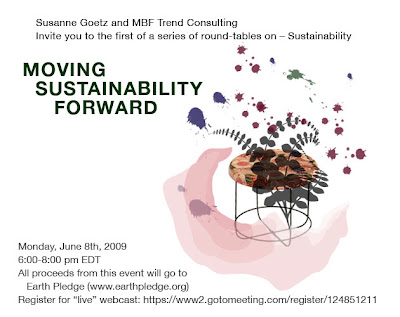
 Click here to view the video!
Click here to view the video!
